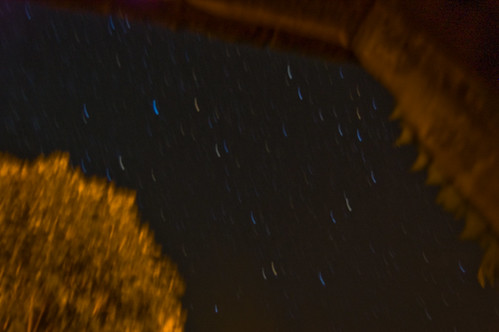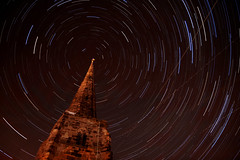First of all. What are star trails?

When you look at the stars at night, they seem to be stuck, but if you stare for a couple of minutes you'll start to realize that they're moving, only very slowly. This effect is created by the earth's rotation and not by the movement of the stars themselves. Every star in the sky makes a whole turn around the pole star. This particular one is right in the axis of the earth's rotation and this causes it not to move in the sky and always head north, that is why this star has been used by travellers thousands of years ago to guide themselves in the night, yes I like science :D but we're moving away from our main topic.
What is the effect of this motion when we shoot stars at night?

If we shoot stars with a shutter speed long enought to capture this movement, the stars will create trails in the form of circles around the polar star, decorating our shot with a very interesting sky.
How do we set up our camera to achieve these results?
This will be a little more complicated than with standard light trails. First of all you will need a remote control, or any other device that allows you to use the bulb mode of your camera. Setting up the maximum 30 sec exposure configured in your camera won't be enough to capture the star's movement.
To set up bulb mode we'll need to go into manual. Se the ISO to minimum, aperture preferably to a high value and shutter speed to bulb mode. Set the focus to manual and focus on infinity.
I also recommend using a long focal length because stars will appear to move faster when the lens is zoomed in.
And this is it, you can start to experiment with different compositions and shutter speeds, keep in mind however that very long shutter speeds will create too much noise in the image, remember turning the noise reduction function of your camera to minimize this effect. If you want to have longer trails, you can create a series of relatively short exposures and then blend them together in photoshop.

It is important to be able to identify the pole star, since all the stars will turn around it, making it a strong subject of your composition. To find it look north and find a very bright star.
And last but not least, keep in mind that this kind of photography works best at clear skies without luminic contamination, so run away from big cities.
Photographs by Corica, Warner Strauss and me.

1 comment:
how do you conbine several pictures?
Post a Comment